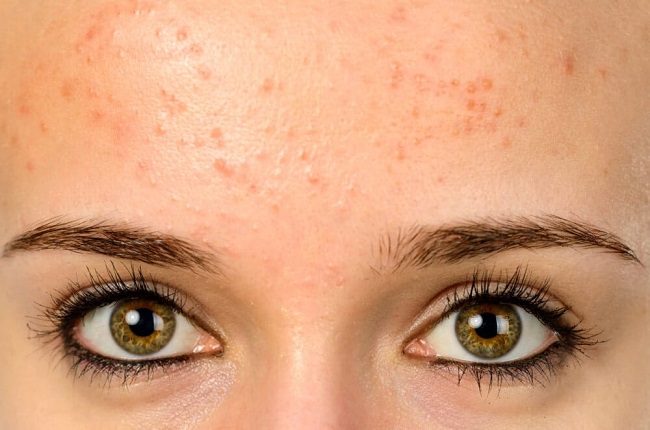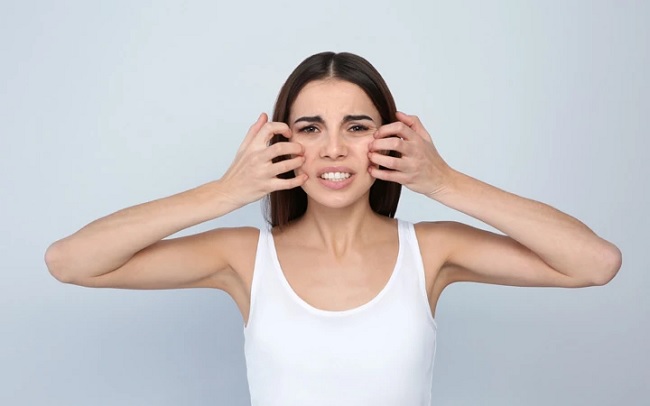Fungal acne is a type of infection in the hair follicles of your skin it usually looks like a small pimple that varies considerably in shape or size, often with a curl.
Fungal acne can cause irritation to the head and skin often confused for acne Vulgaris is the type of acne that is commonly associated with blackheads and headaches. But Fungal Acne and Acne Vulgaris are two different conditions caused by two different things.
They will not respond to the same treatment If you continue to use anti-acne treatment, you can make fungal acne worse.
That’s why it’s important to understand how fungal acne looks and how it develops Read on to learn about the symptoms and symptoms of fungal acne and what you can do to prevent breakouts.
What exactly is fungal acne?
“Fungal pimples are usually popular pimples. One of the symptoms of your acne is fungal and acne obscenity is not diverse which we usually think of as “normal acne” if it gets worse.

Also, if you see a headset or blackhead that is about a millimeter in size, it can be fun. This type of acne is usually seen on the chest, back, or upper arm, but it can also occur on the face, just like normal acne, making it difficult to understand what you are feeling.
Causes and Prevention of Fungal Acne:
There are some reasons for fungal acne; here are what they are and how you can reduce it.
Fungal acne is a little wrong like acne; fungal acne is not mainly caused by oil and bacteria, although oil and sebum production helps to feed fungal acne-causing bacteria.
Instead, pimples and irritated skin, such as pimples associated with fungal acne, are caused by a type of fungal yeast growth.
That is why it is sometimes called fungal acne It is also called Pityrosporum folliculate or Malaysian folliculate.
The yeast responsible for fungal acne is always present in your skin In general, your body is able to balance yeast, other fungi, and bacteria that are also part of your skin.
Trapped moisture: Wearing long-sleeved workout clothes can encourage the growth of dough. Wearing workout clothes without being able to wash can also reveal the fungus that grows on your skin.
Medication: If you take antibiotics, the bacteria in your skin can be reduced. It can allow the growth of a fungus
Suppressed immune system: Defense People with compromised immune systems are more likely to have fungal acne.
Food changes: Fungi and yeast eats on carbohydrates, so balancing sweets and carbohydrate intake helps in fungal growth.
Wearing tight clothes: Wearing breathable clothing on a regular basis can encourage extra horsepower and humidity. It can nourish a dermal environment to increase dough
Warm, humid environment: People living in hot climates, where there is a possibility of overheating may experience fungal acne frequently.
What are the symptoms of fungal acne?
One of the reasons why fungal acne can last so long is that fungal acne looks like Vulgaris or bacterial acne.
People with fungal acne can treat it with regular acne skincare options as they do not know the difference. This treatment does not work, and it can make the infection worse.
Here’s how to tell the difference between fungal acne and bacterial acne:
Size: Plus fillings caused by fungal acne are about the same size. Bacterial acne can cause pimples and headaches of various sizes
Location: Fungal acne is often seen on the arms, chest, and back it can also occur on the face, where bacterial acne is more common.
Itching: Fungal acne is often itchy Bacterial acne is rare.

Clusters: Fungal acne is most often seen in small white clusters Bacterial acne is less clustered and scarcer.
Fungal acne is the result of yeast growth, so you may experience other yeast-related conditions such as psoriasis and dandruff. It can help determine whether your breakout is due to yeast or other reasons.
How to treat fungal acne?
Depending on the severity of the infection, your dermatologist may give you some simple suggestions, such as body wash, or they may prescribe medication.
The doctor says they will recommend including a topical sulfur wash in your daily routine, which is anti-fungal and antibacterial.
Fungal acne is often mistakenly treated because it looks like regular acne many people use anti-acne treatments every day, but they will not work.
In order to properly treat fungal infections, it is necessary to restore the balance between yeast and bacteria in the skin. Many treatment options help to do this.
More regular bathing:
If you work regularly or have a job that gives you a hug, try bathing and changing clothes right after the gym or work. It helps to wash away too much dough which can start to grow in a hot, humid environment that develops in underwear.
Wear Light clothes:
If you wear tight clothing over and over again, friction and low airflow encourage the growth of dough on the skin. Choose a more regular, breathable cloth to keep your skin in proper blood circulation and promote balanced bacterial and fungal growth.
Try a body wash:
Dandruff shampoos made of pyrithione zinc or selenium sulfide can be used as a body wash. This is an off-label use of these shampoos but can be effective. You may also consider using it regularly, once a week, to help maintain a healthy balance of yeast and bacteria in your skin.
Allow sitting on your skin for several minutes before washing the shampoo for best results. Rinse your skin several times a week with these dandruff shampoos while you’re having a breakout.
Try prescription oral antifungal medicine:
If home remedies do not help eliminate breakouts, consider hiring a dermatologist.
Your dermatologist can prescribe an oral hygiene medication, such as itraconazole or fluconazole, to target hair follicles and prevent infection.
Use over-the-counter antifungal treatments:
Various OTC antifungal creams and ointments are available, such as medications for athletes ’feet and jaws.
How can I prevent fungal acne?
While fungal acne cannot be completely prevented, these steps can help reduce the risk of recurrent infections:
Use a dandruff shampoo regularly: This regular wash helps to maintain a healthy balance of yeast on your skin. Once the breakout is over, you can cut down on how many times you use the shampoo once a week like body washes.
Wear breathable clothing: Respiratory fabrics allow for airflow, which can reduce hot, humid environments that promote fungal growth. If changing your clothing options helps treat fungal acne, consider wearing the same type of clothing.
Shower and sweating after bathing: Take a bath washing quickly after work or at work helps prevent dough growth problems.
Eat a balanced diet: Mushrooms are high in carbohydrates, so balance your diet with fruits, vegetables, and protein to discourage more foods.
When should you see a doctor?

If you have tried to treat your suspected fungal acne at home and the breakout lasts for more than 3 weeks, call your dermatologist. Prescription antifungal medications may be more effective in treating infections than topical treatments.
And if the symptoms come back shortly after you think the symptoms have been resolved, consider hiring another dermatologist.
You may be able to find a treatment that will help stop recurrence and prevent possible long-term problems. You can also discuss preventive options with your doctor.
Fungal acne is a type of infection in the hair follicles caused by excessive growth of dandruff. Despite the name, it is not like acne which creates a white head and black head.
Ordinary anti-acne treatment will not work for fungal acne Instead; you need to properly diagnose this type of infection for proper treatment.
If you have taken a second or two to scroll the reedit skincare addiction or the beauty side of ticketing, you are likely to have someone’s fungal acne routine.
They will claim the small pimple on your face that will not only go away but will be cleansed with their remedy. You start to believe that you have fungal acne on your own.
There is some news for you for board-certified dermatologists and misinformation on social media: Fungal acne is not a classification of acne.
This is not the real solution In fact, it’s a make-up name for something completely different from acne, and it usually affects your body – not your face.